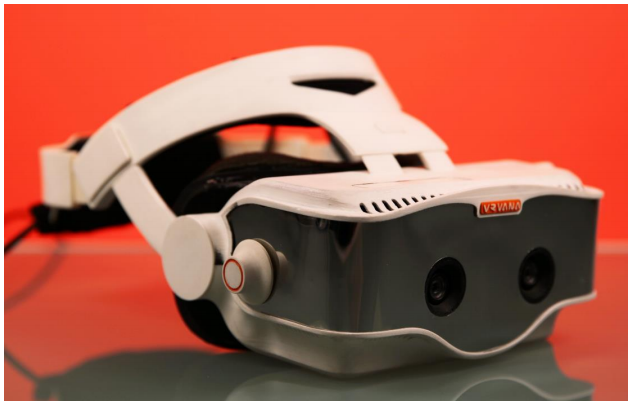Four months after Apple released its long-awaited extended-reality (XR) headset, the Vision Pro is hitting stores in Canada.
Embedded in the gadget is some technology that originally came from the XR company Vrvana, which was founded by Bertrand Nepveu and sold to Apple in 2017.
To understand XR—an umbrella term that encompasses augmented reality, virtual reality, and mixed reality—and its place in the Canadian tech landscape, BetaKit caught up with Nepveu.
The genesis of Vrvana
Before he began his current work investing in media, entertainment, and spatial computing at Triptyq, Nepveu worked at Vrvana to create the Totem headset. The company claimed the product could switch from augmented reality—visual computing that layers digital elements over the real world, à la Pokemon GO—and immersive video, or virtual reality (VR).
In 2017, after Apple acquired Vrvana for an undisclosed sum, Nepveu joined the team developing the Vision Pro under Mike Rockwell, incorporating some of Vrvana’s technology.
Nepveu credits his fascination with XR to video games. He dreamed about playing games from his youth, like Donkey Kong on the 1980s home console ColecoVision, in VR. “For me, it was the ultimate step to go to really fun and immersive games,” he said.
However, it wasn’t until after Nepveu completed both his undergraduate degree in engineering and his MBA that he decided to pursue XR. During his MBA, Nepveu was impressed by the powerful capabilities of the Xbox 360, which he viewed as the best graphics card on the market. He realized that a console paired with a capable graphics card could disrupt the space and bring VR headsets, then a very niche market for hobbyists, to the public.
After this realization, Nepveu approached a few of his colleagues at work and asked them “Do you want to try to do a VR asset?” That marked the birth of Vrvana.
Overcoming Canadian challenges
While working on Vrvana, Nepveu drew inspiration from past Canadian hardware giants such as Nortel, Matrox, and BlackBerry. These stories helped Nepveu reason that “We can be the best [in Canada] if we want to.”
However, the Canadian market’s inherent risk aversion still proved difficult to navigate. “Being ambitious in the States is an asset. In Canada, it’s almost counterintuitive,” he said, adding that investing in hardware scared a lot of VCs.
Nepveu responded to Vrvana’s fundraising difficulties by turning to crowdfunding. Kickstarter allowed Nepveu to secure capital while also testing user interest and market validation. This ultimately helped Nepveu demonstrate Vrvana’s product-market fit to investors.
Real Ventures ended up taking a chance on Nepveu’s venture. At the time, Nepveu recalls how Real Ventures was “the only VC [in Canada] that was not afraid of ambitious people.” Nepveu has been an LP in Real Ventures’ fund since 2018.
Totem’s legacy: Apple acquisition and the Vision Pro
Speaking with BetaKit, Nepveu reminisced about his first interaction with Apple in 2016, which led to a full acquisition by the tech behemoth after Vrvana demonstrated the Totem’s capabilities at CES 2017. At the electronics showcase, Nepveu showed the Totem to Apple’s Jonathan “Jony” Ive.
According to Nepveu, the Totem was key to developing the Vision Pro. Particularly, the Totem’s low-latency Field Programmable Gate Array (FPGA) integration and the “reality knob,” which allowed users to toggle between AR and VR, stood out.
“That was one of the first things they wanted us to patent,” Nepveu explained.
“FPGA is hard,” he continued. “But the good thing is two of my co-founders were doing FPGA. And we hired new people that had that expertise, too. “So that was kind of a superpower we had, what made that Totem so great. We optimized everything so that we had a 12-millisecond latency. And even we did a prototype with Samsung just before the acquisition, and we were at three milliseconds. So we knew that we were able to master the latency.”
The Future of XR in Canada
Nowadays, Nepveu sits on the other side of the table, investing in XR, digital entertainment, and interactive media as a partner at Triptyq Capital in Montréal. Looking forward, Nepveu speculates there is an opportunity for Canadian founders to create high-quality products for XR hardware.
“If you come up with something very innovative that boosts your productivity or a cool game with the current dynamics, you can … make a fortune because there’s not that many competitors right now,.” he said.
At this year’s WWDC, Apple unveiled new tools for developers looking to create apps for the Vision Pro through its new operating software: visionOS 2.
Nepveu also highlighted the role Triptyq’s portfolio company, ShapesXR, is playing in helping developers prototype and test quickly, calling the company a “big enabler.” In a blog post on Medium, Triptyq speculated that Quebec’s rich XR-fluent talent pool could benefit ShapesXR.
Feature image courtesy Bertrand Nepveu.



